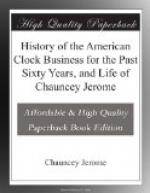Mr. Terry would make two or three trips a year to the
New Country, as it was then called, just across the
North River, taking with him three or four clocks,
which he would sell for about twenty-five dollars apiece.
This was for the movement only. In 1807 he bought
an old mill in the southern part of the town, and
fitted it up to make his clocks by machinery.
About this time a number of men in Waterbury associated
themselves together, and made a large contract with
him, they furnishing the stock, and he making the
movements. With this contract and what he made
and sold to other parties, he accumulated quite a little
fortune for those times. The first five hundred
clocks ever made by machinery in the country were
started at one time by Mr. Terry at this old mill in
1808, a larger number than had ever been begun at one
time in the world. Previous to this time the
wheels and teeth had been cut out by hand; first marked
out with square and compasses, and then sawed with
a fine saw, a very slow and tedious process.
Capt. Riley Blakeslee, of this city, lived with
Mr. Terry at that time, and worked on this lot of
clocks, cutting the teeth. Talking with Capt.
Blakeslee a few days since, he related an incident
which happened when he was a boy, sixty years ago,
and lived on a farm in Litchfield. One day Mr.
Terry came to the house where he lived to sell a clock.
The man with whom young Blakeslee lived, left him
to plow in the field and went to the house to make
a bargain for it, which he did, paying Mr. Terry in
salt pork, a part of which he carried home in his
saddle-bags where he had carried the clock. He
was at that time very poor, but twenty-five years after
was worth $200,000, all of which he made in the clock
business.
Mr. Terry sold out his business to Seth Thomas and
Silas Hoadley, two of his leading workmen, in 1810.
This establishment was the leading one for several
years, but other ones springing up in the vicinity,
the competition became so great that the prices were
reduced from ten to five dollars apiece for the bare
movement. Daniel Clark, Zenas Cook and Wm. Porter,
started clock-making at Waterbury, and carried it on
largely for several years, but finally failed and
went out of the business.
Col. Wm. Leavenworth, of the same place, was
in the business in 1810, but failed, and moved to
Albany, N.Y. A man by the name of Mark Leavenworth
made clocks for a long time, and in the latter part
of his life manufactured the Patent Shelf Clock.
Two brothers, James and Lemuel Harrison, made a few
before the year 1800, using no machinery, making their
wheels with a saw and knife. Sixty years ago,
a man by the name of Gideon Roberts got up a few in
the old way: he was an excellent mechanic and
made a good article. He would finish three or
four at a time and take them to New York State to sell.
I have seen him many times, when I was a small boy,
pass my father’s house on horseback with a clock
in each side of his saddle-bags, and a third lashed




